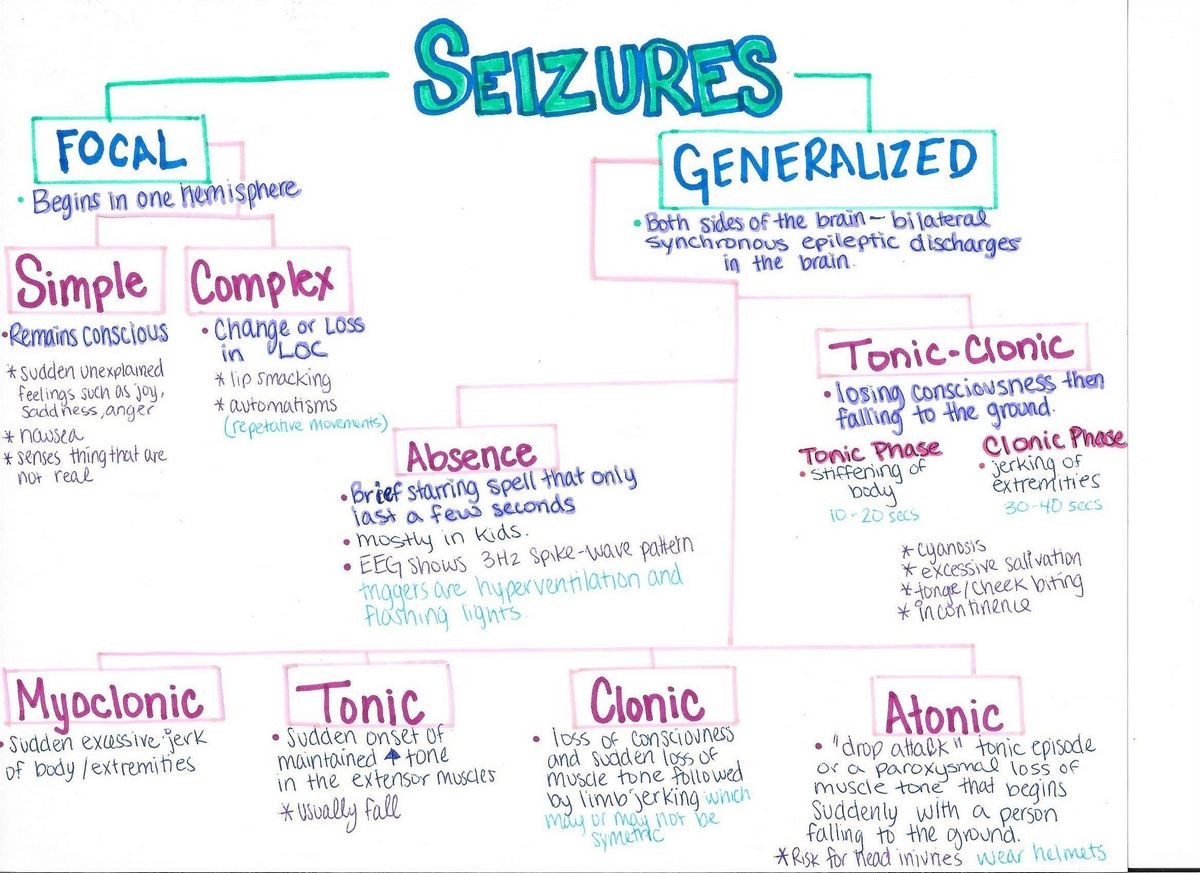
Contents
Seizures: Symptoms and Types
Seizures are disruptions in the electrical impulses of brain neurons. They can cause symptoms that impact muscles, senses, behavior, emotions, or awareness.
Seizure symptoms vary by type:
- Generalized seizures: Disruptions occur on both sides of the brain.
- Partial seizures: Disruptions appear on one side of the brain.
| 1. "Grand Mal" or Generalized tonic-clonic | Unconsciousness, convulsions, muscle rigidity |
| 2. Absence | Brief loss of consciousness |
| 3. Myoclonic | Sporadic jerking movements |
| 4. Clonic | Repetitive jerking movements |
| 5. Tonic | Muscle stiffness, rigidity |
| 6. Atonic | Loss of muscle tone |
Simple (awareness is retained)
- Simple Motor
- Simple Sensory
- Simple Psychological
- Jerking, muscle rigidity, spasms, head-turning
- Unusual sensations affecting vision, hearing, smell taste, or touch
- Memory or emotional disturbances
Why do seizures happen?
A seizure occurs when there is an abnormal burst of electrical activity in the brain that lasts a few seconds to minutes.
There are millions of nerve cells in the brain. Nerve cells transmit small electrical impulses along the nervous system to all regions of the body. When numerous neurons misfire at the same time, it can produce abrupt changes in a person’s feelings, behaviors, and/or awareness.
Symptoms that occur during a seizure depend on the location of the burst of electrical activity, and the strength of these interruptions determines the severity of the disorder.
What conditions cause seizures?
Seizures are often an indication of a more serious condition and can be caused by:
- Mental health issues (bleeding, head injury, or infection)
- Sudden drops in blood sodium levels (usually associated with drinking unusually large amounts of water)
- Fluctuation of blood sugar levels (either too low or too high)
- Brain tumors (relatively rare)
- Stroke
- Pregnancy complications
- Toxin accumulation (kidney failure, liver dysfunction)
- Alcohol or drug use or withdrawal
QUESTION
What are generalized seizures?
Generalized seizures do not begin in one section of the brain but are caused by simultaneous abnormal nerve discharge spikes in the cortex. They can be hereditary but are often due to sleep deprivation or excessive alcohol intake.
Generalized tonic-clonic or grand mal seizures
- The tonic phase of the seizure begins with the person crying out or groaning, stiffens, and collapses unconscious.
- During the clonic phase, the person’s limbs twitch. The jerking diminishes and eventually ceases.
- An episode may last 1-3 minutes, after which the person may feel lethargic, disoriented, irritated, and sleepy.
- Emergency medical treatment is required if the tonic-clonic seizure lasts more than 5 minutes.
Absence or petit mal seizures
- These seizures are common in children and are characterized by a lack of symptoms, resembling staring episodes.
- There are two types:
- Typical absences: Last a few seconds and may go unnoticed. The person becomes blank and unresponsive, staring aimlessly or flickering their eyelids.
- Atypical absences: Similar to typical absences but begin and end more slowly and last slightly longer. Some people may fall due to a shift in muscular tone.
Myoclonic
- Myoclonic seizures are characterized by sporadic jerky movements, with the person aware of what is happening.
- They are brief but can occur in clusters, usually after waking.
- They are classified as generalized seizures because additional seizures, such as tonic-clonic seizures, may occur.
Clonic
- Clonic seizures are characterized by repetitive, rapid stiffening and relaxing of muscles. Restraining the arms or legs will not stop the movements.
- They are uncommon and usually occur in infants.
- Clonic movements are most noticed as part of a tonic-clonic seizure.
- Jerking movements can persist from a few seconds to a minute, and they can be difficult to distinguish from a myoclonic seizure.
Tonic
- Tonic seizures cause sudden rigidity or tightness in the muscles of the torso, arms, or legs.
- The person may be alert or have slightly altered awareness.
- This type of seizure often occurs during sleep and involves all or part of the brain, affecting both sides of the body.
- They typically last less than 20 seconds.
Atonic
- Atonic seizures cause the muscles to become stiff, the person’s eyes to droop, and their head to nod or drop forward. The body may go limp.
- This type of seizure may cause a fall if the person was standing.
- These convulsions usually last no more than 15 seconds.
What are partial seizures?
Partial seizures occur in a specific area of the brain and are commonly associated with injury or trauma.
Meningitis, stroke, developmental impairment, and physical brain injury can cause focal seizures. Symptoms of a focal seizure begin in one section of the brain and can extend to other parts, occurring gradually. They could be preceded by an aura.
As the seizure progresses, additional symptoms such as shaking, fidgeting, muscular rigidity, chewing movements, or disorientation may occur.
Simple partial seizures
- Caused by epileptic activity restricted to one area of the brain, usually the cortex or limbic system.
- Consciousness is unaffected; the person can converse, respond to questions, and recall what happened during the seizure.
- Manifest differently in everyone and are divided into subcategories based on symptoms.
Autonomic seizures or abdominal epilepsy
- Characterized by autonomic symptoms, such as abdominal discomfort or nausea that may rise into the throat to produce stomach pain, borborygmi, belching, farting, and vomiting.
- Pallor, flushing, sweating, hair standing on end, pupil dilation, heart rate and breathing changes, and urination are possible signs.
- Sexual arousal, penile erection, and orgasm may occur in some people.
Emotional simple partial seizures
- Also called temporal lobe auras or simple partial seizures.
- Often manifest as an unusual experience, causing the person to see or hear things that are not present.
- May cause fear, sadness, rage, or joy, and may involve a terrible odor or flavor, a stomach weird feeling, or a choking sensation.
Motor seizures
- Also called Jacksonian motor seizures.
- Convulsive movements can be clonic or jerking.
- Jerking usually starts in one region of the body and may progress to other sections.
Sensory seizures
- Also called Jacksonian sensory seizures and are accompanied by a sensory experience.
- The individual may see lights, hear a buzzing sound, or experience tingling or numbness in a specific area of the body.
Complex partial seizure
- A complex partial seizure follows when epileptic activity extends to both temporal lobes of the brain.
- Does not cause convulsions but compromises consciousness.
- Usually starts with a blank or empty stare. After the seizure begins, the person can no longer answer.
- The person may look confused and becomes ignorant of their surroundings.
- May escalate to chewing movements, uncoordinated activities, or random and awkward behaviors.
Partial seizure with a secondary generalization
- Starts as a partial seizure and progresses to a generalized convulsive seizure.
- Most people with partial seizures have simple partial, complicated partial, or secondary generalized seizures.
- Medication can manage seizures in about two-thirds of people with partial epilepsy.
- Frequently treated surgically when medications do not work.


